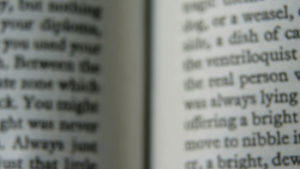
DSM 5? I’m an open book about this book I’ve opened. [image description: photo of the pages of an opened book]
originally published September 18, 2013
Index
Part 1: Losing Your Diagnosis?
Part 2: Diagnostic Criteria: Section A
Part 3: (you are here)
Part 4: Diagnostic Criteria: Section C
Part 5: Diagnostic Criteria: Section D
Part 6: Diagnostic Criteria: Section E and Severity Levels
Part 7: Development and Course: Part 1
Part 8: Development and Course: Part 2
Part 9: Development and Course: Part 3
Part 10: Development and Course: Part 4
Today I’m looking at section B of the DSM-5 diagnostic criteria for autism. And I am awkwardly typing around a cat who decided this was the best time ever to conquer my lap.
B. Restricted, repetitive patterns of behavior, interests, or activities, as manifested by at least two of the following, currently or by history (examples are illustrative, not exhaustive; see text):
1. Stereotyped or repetitive motor movements, use of objects, or speech (e.g. simple motor stereotypies, lining up toys or flipping objects, echolalia, idiosyncratic phrases).
2. Insistence on sameness, inflexible adherence to routines, or ritualized patterns of verbal or nonverbal behavior (e.g., extreme distress at small changes, difficulties with transitions, rigid thinking patterns, greeting rituals, need to take same route or eat same food every day).
3. Highly restricted, fixated interests that are abnormal in intensity or focus (e.g., strong attachment to or preoccupation with unusual objects, excessively circumscribed or perseverative interests).
4. Hyper- or hyporeactivity to sensory input or unusual interest in sensory aspects of the environment (e.g., apparent indifference to pain/temperature, adverse response to specific sounds or textures, excessive smelling or touching of objects, visual fascination with lights or movement).
Specify current severity: Severity is based on social communication impairments and restricted, repetitive patterns of behavior (see Table 2).
Again, some of the things I pointed out yesterday – the very helpful illustrative descriptions of types of behaviors and traits that fit into these categories, and a broad range of affectedness listed. Also the “currently or by history” phrase that is so helpful for someone who is having a hard time now and needs a diagnosis to help them but is not currently manifesting all the symptoms required for diagnosis (but manifested sufficient for diagnosis in the past.)
Section B is the only section in the diagnostic criteria that is not all-or-nothing. An individual only needs two of these traits for diagnosis. So instead of the thousands of different permutations Alyssa found in DSM-IV, there are only 6 permutations in the diagnostic criteria of DSM-5 (4 items combine in 6 unique pairs: 1&2, 1&3, 1&4, 2&3, 2&4, 3&4.)
The other big thing I want to note with this section before I go on with the rest of my day is number 4: “Hyper- or hyporeactivity to sensory input or unusual interest in sensory aspects of the environment (e.g., apparent indifference to pain/temperature, adverse response to specific sounds or textures, excessive smelling or touching of objects, visual fascination with lights or movement).”
I am so happy to see that in the official criteria!
Everybody who knows an Autistic person and every person who is Autistic knows . . . KNOWS . . . that there is “this sensory stuff” that goes along with autism. There has been a lot of debate and discussion over whether they are additional co-morbids or part of autism itself. And it’s been confusing because our “sensory stuff” is so different from person to person.
I have hyperacusis – high pitched sounds make me dizzy, fall over, nauseated, etc. But I have no problem with *loud* sounds — in fact, I am a drummer. Other Autistics have a hard time with *any* loud sound. I know a married couple and she has hypersensitivity to sound and he has hyposensitivity to sound. So he has a deep need for sound stimulation and puts on loud music and she is assaulted by it because she needs lots of quiet. It’s hard on them. But they’re both Autistic and know that about themselves so they work out ways to get both their needs met.
I am so happy to see hypersensitivity and hyposensitivity listed in the diagnostic criteria. The way section B is worded, the authors acknowledge that not *every* Autistic person deals with sensory issues. But it also accepts that it’s a huge issue for a large number of us. Thank you, DSM-5 committee. It’s about time!
I don’t have anything more to say today. I may combine C, D, and E in one post because they’re so short. Then we’ll move on to the severity table and the DSM-5 discussion of severity levels (which is SO AWESOME! I am having a hard time waiting to get to that part!) and then move into some of the other things in the discussion section of the DSM-5 entry on autism.
But now it’s time for me to have some breakfast and run some errands so I will be back tomorrow with another DSM-5 post. Have a great day and be nice to your Autistic (especially if your Autistic is YOU!)

Recent Comments